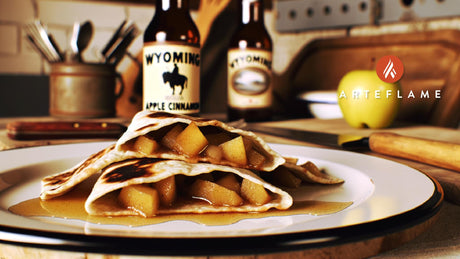Introduction
Préparez-vous à déguster un classique savoureux du Wisconsin : des bouchées de bratwurst grillées, nappées de fromage à la bière crémeux et dorées à la perfection sur le gril Arteflame. Cette recette capture l'essence même des grillades du Midwest avec une cuisson croustillante et un fromage fondu onctueux, le tout préparé sur la plaque de cuisson plate et la grille centrale directe. Parfait pour les en-cas des jours de match ou les repas entre amis !
Ingrédients
- 4 saucisses bratwurst (de préférence fabriquées dans le Wisconsin)
- 1 tasse de cheddar fort râpé
- 4 oz de fromage à la crème, ramolli
- 1/2 tasse de bière (lager ou ale)
- 2 cuillères à soupe de beurre (pour les grillades et la sauce au fromage)
- 1 cuillère à café de poudre d'ail
- 1/2 cuillère à café de paprika fumé
- Sel et poivre fraîchement moulu au goût
- Ciboulette fraîche hachée (facultatif pour la garniture)
Instructions
Étape 1 : Allumez le gril Arteflame
- Faites tremper trois serviettes en papier dans de l’huile végétale.
- Placez les serviettes au centre du gril Arteflame.
- Empilez du bois de chauffage sur les serviettes et allumez-les.
- Laissez le gril chauffer pendant environ 20 minutes jusqu'à ce que la grille centrale atteigne plus de 1 000 °F, ce qui est parfait pour saisir.
Étape 2 : Griller et trancher les Bratwursts
- Placez les saucisses sur la plaque de cuisson plate près de la zone centrale la plus chaude.
- Cuire jusqu'à ce que le tout soit bien carbonisé et que la température interne atteigne 150 °F.
- Retirer et laisser reposer 5 minutes, puis couper en rondelles épaisses.
Étape 3 : Préparez du fromage à la bière sur la plaque chauffante
- Sur le bord extérieur du plateau, placez le beurre et laissez-le fondre lentement.
- Ajoutez le fromage à la crème et remuez jusqu'à consistance lisse.
- Versez lentement la bière en remuant constamment.
- Ajoutez le cheddar, l'ail en poudre, le paprika, le sel et le poivre. Remuez jusqu'à obtenir une consistance veloutée et lisse. Si la sauce épaissit trop vite, éloignez-la du centre.
Étape 4 : Saisir les bouchées de brat sur la grille centrale
- Trempez chaque rondelle de bratwurst à moitié dans le fromage à la bière et placez-la côté fromage vers le haut sur la plaque de cuisson plate près du centre chaud pour qu'elle prenne légèrement.
- Une fois pris, placez rapidement le côté fromage vers le bas sur la grille centrale du gril pendant 30 secondes, jusqu'à ce qu'il soit doré et bouillonnant.
- Retirer lorsque la température interne atteint 165 °F. Retirer du gril à 150 °F pour permettre la cuisson ultérieure.
Étape 5 : Dresser et garnir
- Placez les bouchées de saucisse sur un plat de service.
- Arroser le dessus du reste de fromage à la bière.
- Parsemez de ciboulette hachée pour décorer et servez immédiatement.
Conseils
- Utilisez un cheddar fort pour une saveur audacieuse ou ajoutez du pepper jack pour une touche supplémentaire.
- Laissez le fromage à la bière épaissir lentement sur l'anneau extérieur de la plaque de cuisson ; trop de chaleur peut provoquer une séparation.
- Surveillez toujours les zones du gril pour des températures de cuisson optimales. Déplacez les aliments si nécessaire.
- Utilisez un thermomètre à viande et retirez les morceaux de bratwurst à 150 °F pour une jutosité optimale.
- Utilisez de véritables saucisses et du fromage du Wisconsin pour une saveur locale authentique.
Variations
- Bouchées de fromage à la bière et au jalapeño épicé:Ajoutez 2 cuillères à soupe de jalapeños frais coupés en dés à la sauce au fromage et garnissez de jalapeños marinés tranchés.
- Bouchées de saucisses fumées au barbecue: Mélangez 1 cuillère à soupe de sauce barbecue dans la sauce au fromage et terminez avec du gouda fumé au lieu du cheddar.
- Bouchées de choucroute à l'allemande: Ajoutez une couche de choucroute entre la tranche de bratwurst et le fromage à la bière. Saupoudrez de graines de carvi.
- Bouchées en croûte de bretzel:Appuyez les morceaux de bretzel écrasés sur le côté fromage avant de saisir pour un croquant salé.
- Bouchées de saucisses bratwurst garnies de bacon:Mélanger le bacon émietté au fromage à la bière et garnir d'une pincée d'oignons verts.
Meilleurs accords
- Lager froide du Wisconsin ou IPA
- Bretzels grillés ou bouchées de bretzels moelleux
- Salade de chou crémeuse
- cornichons à l'aneth
- salade de pommes de terre allemande
Conclusion
Cette recette de bratwurst grillée, inspirée du Wisconsin, est une véritable merveille. Grâce à la cuisson uniforme de la surface plane de l'Arteflame et à la puissance de la grille centrale, vos saucisses auront un équilibre parfait entre la texture juteuse de la viande et le fromage crémeux. Savourez chaque bouchée dorée !
